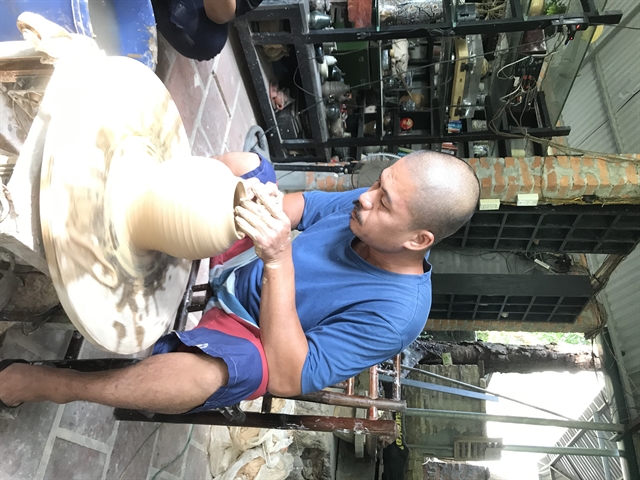Artist Vũ Đức Hiếu is known for his love of the Mường ethnic minority’s traditional culture and set aside 5 hectares of his own land to promote it in a private museum, which saw him win at the Jeonju International Awards for Promoting Intangible Cultural Heritage. Lê Hương spoke with him about his life-long endeavour.

WORK & PASSION: Painter Vũ Đức Hiếu crafting ceramics at the museum. VNS Photo Lê Hương
Inner Sanctum: How did you come to know about the Jeonju International Awards?
I knew of them through the network of museums in Việt Nam.
The awards aim to recognise those who have devoted their energies to the universal values of humanity, transcending nation, ethnicity, religion, and gender.
Winning projects are viewed as models to be replicated elsewhere around the world.
I thought the awards were quite suitable with what I have been doing, so decided to put my name forward.
Inner Sanctum: Can you tell us a little about your Mường Culture Space Museum?
It opened in December 2007 after ten years of gathering together objects and materials for display. It is now divided into three different exhibiting areas on 5ha of rolling hills in the northern province of Hòa Bình - a cradle of the Mường ethnic group.
The first area focuses on the living space of Mường society and its classes in ancient times, as well as stilt-houses of the King (nhà Lang), houses of mandarins (nhà âu), houses of ordinary people (nhà noóc), and houses of the poor (nhà noóc trọi).
It also showcases the group’s festivals and folk games.
The second exhibiting area features things like fishing, traditional weaving, and the spiritual lives of the group.
The third displays paintings and ceramics from contemporary artists who created their works in the lands of the Mường and were inspired by the local culture.
My family also lives at the museum.
Inner Sanctum: How many visitors do you welcome each month?
We are open every day except Monday, and welcome more than 10,000 people a year.
Inner Sanctum: Have you had any difficulties running a private museum? How do you get over the obstacles?
Mine is one of 30 private museums in Việt Nam, and there are about 100 public museums all around the country. The Government covers everything at public museums, like land, infrastructure, and the cost of collecting and preserving the objects on display, salaries for the staff, and other general operating expenses.
We private museums, however, have to manage everything ourselves, which is the biggest challenge. Few museums around the world can raise enough money from selling tickets to stage frequent activities or make investments.
We have done what we can by whatever means we can find. We have offered tourism services at the museum, such as teaching culture and heritage to school students. But the earnings from this are nowhere near enough to run the museum.
Inner Sanctum: How did you come up with the idea of opening the museum? Why the Mường culture?
I travelled to different parts of the country when I was a student. On these trips I saw ancient cultures being eroded by industrialisation and modernisation. Many objects of ancient cultures were broken or destroyed, yet each has its own interesting story to tell.
I also collected objects along the way and came to discover their cultural values. I bought this land in Hòa Bình Province in the hope of passing on the cultural values of the group to the younger generation.
The Mường are an important root of the ancient Vietnamese people, and based mostly in Hòa Bình. Its population currently accounts for 7 per cent of the province’s total, and there are 1 million Mường people around Việt Nam.
I want to share my passion for Mường culture with the community and hope that people respect it and help preserve it, as it has been fading away. That’s why I built the museum.

RE-CREATED: Hiếu in the Nhà Lang (a house of a Mường King) he rebuilt in the museum, after the first burned down accidentally in 2013. VNS Photo Lê Hương
Inner Sanctum: Are you happy with what you have today?
Not totally, because I still have many ideas and tasks to pursue. I’m fairly contented, though, with running the museum, as I’ve received great support from culture lovers as well as patriots, which I think proves that my approach to preserving and developing traditional Mường culture is on the right track.
Inner Sanctum: What are your future plans for the museum?
I will continue to promote ethnic Mường culture to the world, by organising exhibitions or hosting artistic workshops at the museum, so that international friends can come and find out more. VNS
OVietnam